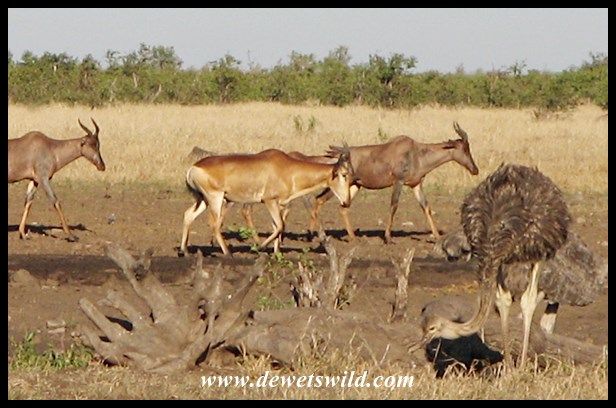Alcelaphus buselaphus lichtensteinii
Lichtenstein’s Hartebeest is a large antelope occurring in marshland and floodplains and the adjacent grasslands and woodlands of East-Central Africa, where they subsist almost exclusively on a grazing diet and requires daily access to drinking water. Bulls can weigh up to 200kg with a shoulder height of up to 1.36m, with cows being slightly smaller. These hartebeests often have a dirty patch on their flanks, due to their habit of wiping their faces and horns clean against their sides.

Lichtenstein’s Hartebeest are diurnal animals, being most active in the early morning and evening. They keep in small family groups consisting of a territorial bull, several adult cows (who apparently has a hierarchy linked to their age) and their calves. Bigger groups are just temporary and form in response to localised favourable grazing. Solitary bulls and bachelor groups also occur and move on the fringes of the territories held by the breeding bulls in the areas with the best grazing. Territories are demarcated through scent marking and dung piles and bulls will get involved in serious fights to prevent their harems being stolen by neighbours or interlopers. Lichtenstein’s Hartebeests often associate in mixed herds with wildebeest, impala and other herbivorous creatures, and are as curious as they are athletic. They fall prey to all Africa’s larger predators. Single calves are normally born at the end of the dry season.

A Lichtenstein’s Hartebeest mixing with tsessebe and ostrich at Tinhongonyeni waterhole in the Kruger National Park.
South Africa has only one very small population of about 50 Lichtenstein’s Hartebeest occurring in the Kruger National Park, to where they were reintroduced from Malawi in the 1980’s after being hunted to local extinction at the end of the 19th century. We’ve been lucky to have a handful of sightings of them in Kruger near Punda Maria, Mopani and Pretoriuskop. Lichtenstein’s Hartebeest are still numerous enough, especially in Tanzania and Zambia, for the IUCN to consider their populations stable and their conservation status as “Least Concern“, with an estimated population of around 82,000, though they also do highlight that the subspecies is vulnerable to poaching and reliant on continued protection in formal conservation areas.
Some authorities consider Lichtenstein’s Hartebeest to be a seperate species from other races of the Common Hartebeest (A. buselaphus), also represented in South Africa by the Red Hartbeest (A. buselaphus caama).


Ek laaaik! Interesting second photo. Looks like reindeer antlers lying in the front and then, one has to look closely to see that the fur ball is actually an ostrich! I reckon, if you tweak the photo it will make a great talking point! 😉
LikeLiked by 1 person
Thanks AJ! It was one of our most memorable sightings with no less than 3 species of rare antelope at the same waterhole at the same time (the eland is just outside this shot).
LikeLiked by 1 person
Great! Mind you… I’m having difficulty not mentioning that other “b” stuff! But then… as you say, maybe I must remember they’re rare! 😉 Fantastic sightings, I wish I could live in your camera!! 😀
LikeLiked by 1 person
Dis nou interessant,Dries.Ek het nie geweet daar is ‘n groepie in die Krugerwildtuin nie!Sal bietjie uitkyk as ons weer daar kom.
LikeLiked by 1 person
Sal duim vashou vir julle, Dina!
LikeLiked by 1 person
Mooi mooi!
LikeLiked by 1 person
Nogmaals dankie, Tina!
LikeLiked by 1 person
Soos altyd, baie interessant dankie.
LikeLiked by 1 person
Baie dankie Toortsie! Ai, ek wens die mofhartbeeste was meer volop en beter bekend in ons land.
LikeLiked by 1 person
Pingback: Red Hartebeest | de Wets Wild